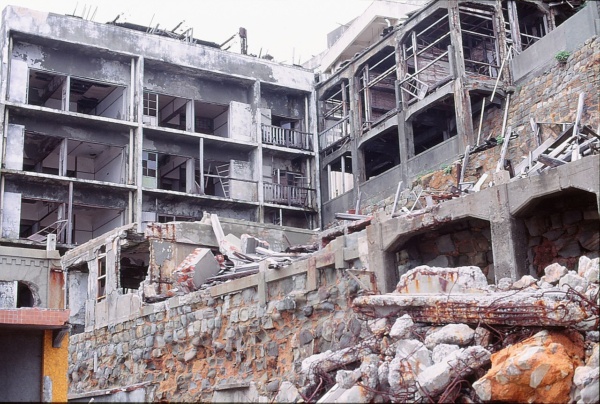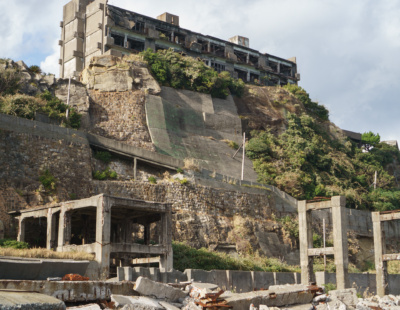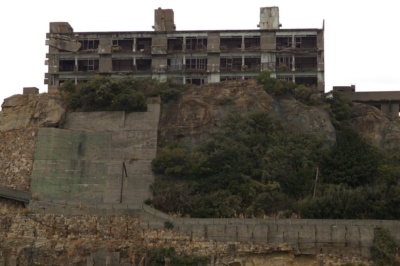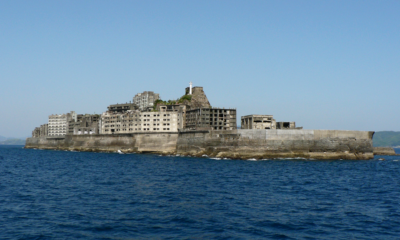
Hashima Island began life as a vibrant coal mining facility. At one point, with a population density of over 83,500 people per square kilometer, it was the most densely populated piece of land on the planet.
About 9 miles from Nagasaki, where the second atomic bomb was dropped (and reportedly shook buildings on tiny island), Hashima is only 16-acres, barely 2/100 of a square mile, and is lined with multi-story apartments, business offices, and manufacturing facilities.
Today, aside from rats and a few feral cats, the population of the island is zero and visitors to the deserted land mass say the abandoned and undisturbed buildings look like the shocking aftermath of a zombie apocalypse.
History of Hashima Island
Less than an hour’s boat ride from the shores of Nagasaki, Hashima Island opened its doors in 1887 when a rich coal deposit was discovered underneath the island. Three years later, Mitsubishi Corporation purchased the speck of rock and five years later, began drilling into the seabed to extract the embedded coal. By 1916, over 3,000 people called the island home and Mitsubishi constructed more permanent facilities to support the growing population.
Slag from the mine was used to build more land mass, expanding and shaping the island, and a sea wall was constructed to protect inhabitants against Japan’s savage typhoons. As a result, the island took on a distinct battleship shape, hence the name “Gunkanjima”, which means “Battleship Island”. Concrete apartment buildings sprung up throughout the island including a mammoth nine-story structure that at the time, was the largest concrete structure in all of Japan.
As Japan rebuilt after the War, demand for coal increased and the population on the island grew as more workers were brought in to meet the increasing demand. According to Mysterious Universe:
“During the height of Hashima’s prosperity in the 1950s, the island sported a small city complete with 30 large concrete buildings, various retail stores, a supermarket, hospital, schools, library, gymnasium, hairdresser, movie theater, bars, restaurants, an outdoor swimming pool, temple, shrine, and even a pinball parlor, brothel, and dance hall, all crammed onto a tiny island barely the length of 12 football fields. The island was so small that one could walk from one side to the other in mere minutes, making roads and motor vehicles unnecessary.”
By 1960, over five thousand people were packed on the tiny island making its population density nine times that of Tokyo (which at the time, was itself one of the most densely populated areas on Earth). Food and supplies were shipped to the island daily. Apartment buildings, many containing hundreds of single-room units, were linked with businesses and shops via a series of bridges, elevated walkways, and tunnels. Living conditions improved dramatically with the introduction of electricity and water delivered via undersea pipes from reservoirs on the mainland.
The abandonment of Hashima Island
By 1960, the tide began to turn as nations switched from coal to oil-based fuel sources. Mitsubishi relocated employees to other plants for over a decade before finally closing the mine altogether in 1974. With the primary economic driver on Hashima Island washed up, the citizens that remained left the island in mass to find employment elsewhere. Residents and businesses were in such a rush to reach the mainland, many left their belongings behind giving the island the appearance of a city frozen in time.
Visiting Japan’s Hashima Island
Today you may visit Hashima Island via private tourist boats (for safety reasons, not all of the island is open to visitors). Visitors to the island will find an eerie, abandoned city reminiscent of a post-apocalyptic wasteland. One visitor to the island described what he saw during his visit to the island:
“Upon entering apartments here, one can find lived in rooms that remain as they were when people were here, with TV sets, furniture, and sometimes even plates, food and sake bottles set out on tables waiting to serve dinner to someone who will never come. Dead telephones remain in the rooms and one gets the creepy feeling that one might just suddenly start ringing at a moment’s notice. The abandoned school still has dust covered desks lined up complete with textbooks dutifully laid out for class. The island’s hospital is still stocked with dusty bottles and vials of medicine as well as abandoned medical equipment, some of it in remarkably pristine condition. Restaurants still have broken down refrigerators filled with long rotted food that was left behind, yet the tables are curiously set up as if to receive customers at any time.”
The island was owned by Mitsubishi Material up until 2002, when it was voluntarily transferred to Takashima town. Currently, Nagasaki city, which absorbed Takashima town in 2005, exercises jurisdiction over the island. A small portion of the island was re-opened for tourism on April 22, 2009. Since the abandoned island has not been maintained, several buildings have already collapsed. Given its unique appearance, it has been featured in shows such as Life After People and Forgotten Planet and used as a set in several movie productions.
Hashima Island/Gunkanjima pictorial gallery
Check out the Hashima Island pictorial below (click photo for full-size view).












































Image Credits
In-Article Image Credits
Hashima Island, Japan via RedditView from the Hizen Hashima Lighthouse Battleship Island Nagasaki Japan via Wikipedia Commons by Gohachiyasu1214 with usage type - Creative Commons License. May 4, 1992
Fourth mine pit hoistroom Hashima Island via Wikipedia Commons by Gohachiyasu1214 with usage type - Creative Commons License. May 4, 1992
Stairway To Hell, Gunkanjima Hashima Island via Wikipedia Commons by Jordy Meow with usage type - Creative Commons License. November 28, 2010
Hashima Island Nagasaki Japan from the water via Wikipedia Commons by Hisagi with usage type - Creative Commons License. April 23, 2009
Buildings and so-called the Stairway to Hell, Hashima Island, Japan via Wikipedia Commons with usage type - GNU Free
The Shiofuri street (salt-spray street) on Hashima Island via Wikipedia Commons by Gohachiyasu1214 with usage type - Creative Commons License. May 4, 1992
Hashima Island Building 12 Building 23 Building 22 via Wikipedia Commons by Gohachiyasu1214 with usage type - Creative Commons License. May 4, 1992
Third floor of the Hashima Elementary and Junior High School gymnasium via Wikipedia Commons by Gohachiyasu1214 with usage type - Creative Commons License. May 4, 1992
Hashima Island office buildings via Wikipedia Commons by Gohachiyasu1214 with usage type - Creative Commons License. May 4, 1992
Buildings and rubble on abandoned Hashima Island via Wikipedia Commons with usage type - Creative Commons License
Hashima Island Elementary and Junior High School buildings via Wikipedia Commons by Ka23 13 with usage type - Creative Commons License. August 13, 2017
Hashima Island Building 65 Kindergarten and Nursery shoe rack via Wikipedia Commons by Gohachiyasu1214 with usage type - Creative Commons License. May 4, 1992
Building 65 the classroom of the Hashima Kindergarten and Nursery via Wikipedia Commons by Gohachiyasu1214 with usage type - Creative Commons License. May 4, 1992
Hashima Island Nagasaki Pref Japan via Wikipedia Commons with usage type - GNU Free. August 11, 2011
Hashima Island Building 65 Building 70 via Wikipedia Commons with usage type - GNU Free
Hashima Island Building 31, Building 25, Building 30 via Wikipedia Commons with usage type - GNU Free
Dorr thickener on Hashima Island via Wikipedia Commons by Gohachiyasu1214 with usage type - Creative Commons License. May 4, 1992
Hashima Island from the seventh floor of the Hashima Elementary via Wikipedia Commons by Gohachiyasu1214 with usage type - Creative Commons License. May 4, 1992
Ruins of belt conveyor and Hashima Elementary and Junior High School via Wikipedia Commons by Ka23 with usage type - Creative Commons License
Building 31 company housing for miners Hashima Island via Wikipedia Commons by Gohachiyasu1214 with usage type - Creative Commons License. May 4, 1992
Crumbling buildings on Battleship Island Japan via Wikipedia Commons by VKaeru with usage type - Creative Commons License
Hashima 17 and 18 Building Rooftops via Wikipedia Commons by Gohachiyasu1214 with usage type - Creative Commons License. May 4, 1992
Concrete buildings on Hashima Island via Wikipedia Commons by VKaeru with usage type - Creative Commons License. December 19, 2015
Damaged structures in Gunkanjima, Nagasaki, Japan via Wikipedia Commons by Jordy Meow with usage type - Creative Commons License
Gunkan Jima Hashima Battleship Island Japan via Wikipedia Commons by take-see with usage type - Creative Commons License. January 8, 2006
Gunkan Jima Hashima Battleship Island Japan via Wikipedia Commons by take-see with usage type - Creative Commons License
Gunkan Jima Hashima Battleship Island Japan via Wikipedia Commons by take-see with usage type - Creative Commons License. January 8, 2006
Gunkan Jima Hashima Battleship Island Japan via Wikipedia Commons by take-see with usage type - Creative Commons License
Gunkan Jima via Wikipedia Commons by take-see with usage type - Creative Commons License
From the sea Hashima Island August 2017 via Wikipedia Commons with usage type - Creative Commons License
Gunkanjima. A view from the school. via Wikipedia Commons by Jordy Meow with usage type - Creative Commons License
Hashima Park (children's park) via Wikipedia Commons by Gohachiyasu with usage type - Creative Commons License
The Block 65 on Gunkanjima in 2012 via Wikipedia Commons by Jordy Meow with usage type - Creative Commons License
Hashima Island. 2 Takashimamachi, Nagasaki-shi, Nagasaki-ken via Wikipedia Commons by Fumihiko Ueno with usage type - Creative Commons License
Abandoned collapsing building on Hashima Island Battleship Island Japan via Flickr with usage type - Creative Commons License
Nagasaki Hashima Island Gunkajima Tour via Flickr by Ronald Woan with usage type - Creative Commons License
Google Street View of the abandoned coal factory at Hashima Island via Flickr with usage type - Creative Commons License
Abandoned building on Hashima Island via Flickr by CK Leung with usage type - Creative Commons License
Hashima Island via Flickr by CK Leung with usage type - Creative Commons License
Abandoned building on Hashima Island via Flickr by CK Leung with usage type - Creative Commons License
Hashima Island, also known as Battleship Island) 2008, Nagasaki via Wikipedia Commons by kntrty with usage type - Creative Commons License
Nagasaki Hashima via Wikipedia Commons by Hisagi with usage type - Creative Commons License. April 23, 2009
Hashima Island Nagasaki Pref Japan via Wikipedia Commons with usage type - GNU Free. August 18, 2011
Featured Image Credit
Hashima Island, Japan via Reddit











